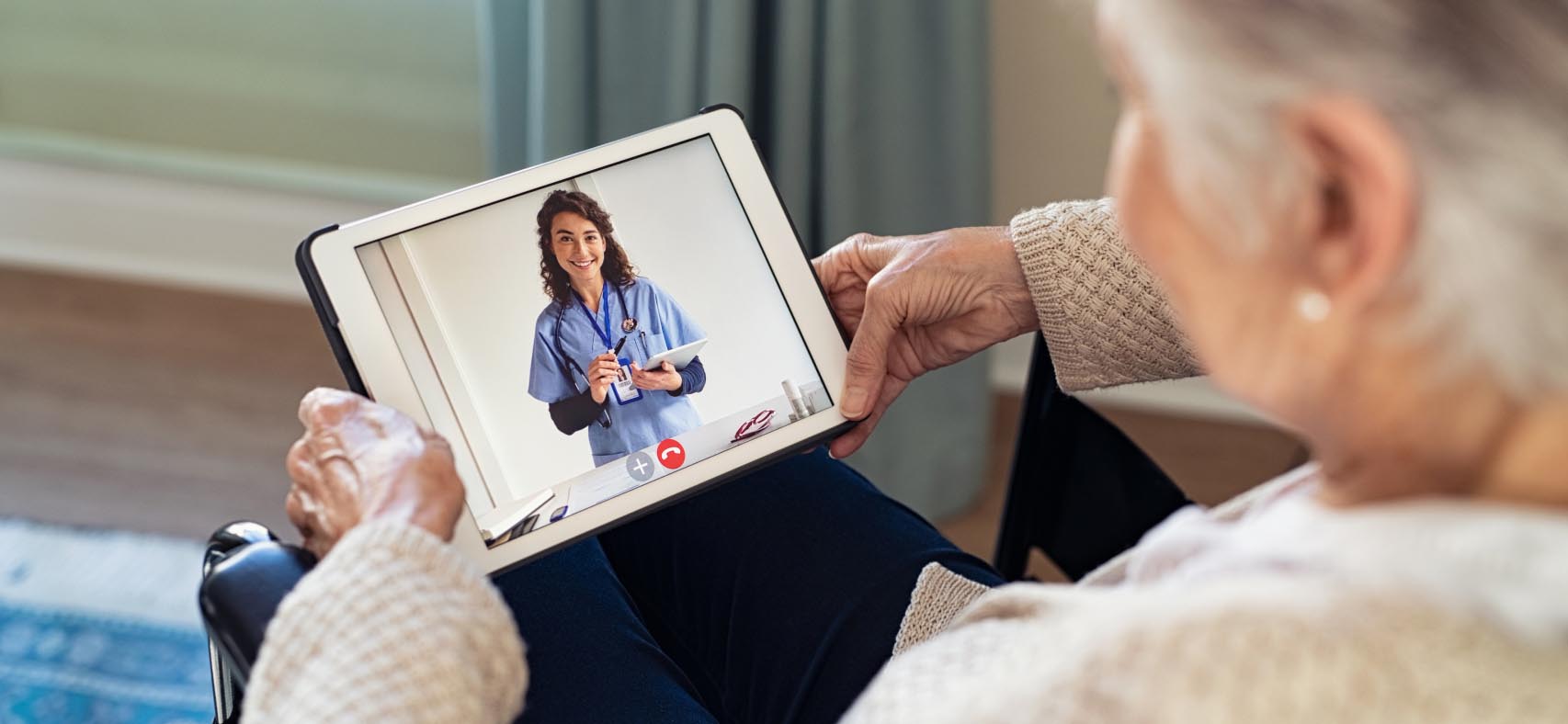For both providers and health plans, one strategy to create consumer-grade experiences is to build a “digital front door.” This could be an app or platform where people can access and manage all of their healthcare requirements, such as booking doctor’s appointments, making payments, arranging follow-up care, managing pharmacy prescriptions and more. It is unlikely that there will ever be one provider that can “own” this portal, so it is important that any approach is interoperable and facilitates the easy sharing of data.

7 min read
Key takeaways
- The healthcare industry is going through a major period of digital transformation to provide better care at lower cost for more people.
- During this shift, companies across the healthcare continuum must use payments technology as a strategic lever that is integral to change.
- In this report, you’ll find insights into how businesses can leverage payments to deliver better care while scaling sustainably through improved payments processes.
Payments are a strategic lever for better care
- The healthcare industry is going through a major period of digital transformation to solve a fundamental challenge – how to provide better care, at lower cost for more people. Healthcare companies across the care continuum are shifting focus from symptomatic treatment to holistic care, preventative treatment and health maintenance.
- A key component of this new approach is payments technology, which is becoming a strategic lever that is integral to change. This is because payments have an impact at every part of the healthcare ecosystem from patient care to complex business-to-business (B2B) relationships. Whether it is a patient trying to pay a medical bill, a pharmaceutical company paying a regulatory body, a clinical research organization paying trial participants, or a manufacturer working with distributors to deliver shipments on time, making payments faster, simpler and more transparent can help the system work better for everyone involved.
- In this report, you’ll find insights into how businesses can leverage payments to deliver better care while scaling sustainably through improved payments processes.
Increasing consumer centricity
- Digitalization is continuing to transform all industries; in fact, investment in direct digital transformation will reach $6.3 trillion between 2022-20241. But the healthcare industry remains notoriously complex and fragmented, with consumers struggling to manage different providers and healthcare operators. This is a huge area of opportunity for healthcare companies, as 70% of consumers are open to using a unified digital platform to manage their healthcare needs2. To improve member centricity via digitalization, healthcare business can focus on three key areas of opportunity:
For providers, payments can create better experiences across five main patient touch points:
- Pre-service: Patients research a location, evaluate potential cost, and read reviews. Providers should outline potential payment options online for transparency in this step.
- Intake: Have clear, collaborative conversations during intake about the type of care needed, preferred payment methods, and potential costs.
- Point-of-care: Shift from transactional care to focus on the patient experience. Use appropriate technologies like telehealth to improve access, increase speed and lower costs.
- Post-care: Use digital technologies to offer options like payment plans or paperless billing.
- Follow-up: Use a digital front door to stay in touch, schedule follow-up appointments, or automate prescription refills.
- In a time of rising costs and squeezed budgets, employee morale is suffering and there is a growing staffing shortage, especially among nurses. 29% of resident nurses said they’re likely to leave their current role in patient care3. Frequent complaints include burnout and insufficient pay.
- Although payments cannot solve wider systemic issues, improved payment practices can benefit employees. For example, earned wage access (EWA) solutions can allow health workers to draw down portions of their salary before pay day, easing any financial burden.
Inclusion and equality in healthcare
- One of the most important priorities for healthcare organizations is to advance health equity4, specifically for underserved populations and communities. But the challenges to inclusivity and equality are countless. Barriers include:
- High cost of care: 38% of U.S. adults reporting they had skipped some form of healthcare, be it a test5 or a doctor’s appointment, due to the financial burden.
- Accessibility and availability: It is estimated that 30 million Americans do not live within a 60 minute drive of a trauma center, while 80% of rural Americans are medically underserved.6
- Implicit bias in healthcare: Implicit biases can impact healthcare across numerous touchpoints, including patient care, medical school admissions, hiring, promotion and growth opportunities.7
- To remove barriers for inclusive care, businesses can reevaluate core strategies including:
- Telehealth and remote medicine: Remote medicine can reduce healthcare costs by quickly resolving many health issues and therefore preventing unnecessary usage of more expensive care settings such as hospitals.
- Payments strategies: Upfront cost estimates, discounts for settling before terms, and patient support programs (PSPs) can solve affordability issues for patients while allowing providers and pharmaceutical companies to better manage cashflow.
- Artificial intelligence: AI can help address preventable care needs, automate backend functions like payment reminders, and free up time for providers to focus on high-value care.
- Preventative medicine: Increased data sharing between members of the healthcare ecosystem can help encourage preventative medicine in underserved populations.
“The only way to improve member experience, which is now mission critical, is to also concurrently significantly improve employee experience.”

Nick Webb
Healthcare futurist and CEO of Leader Logic, LLC
Interconnected healthcare ecosystem
Payments connections between members of the healthcare ecosystem can inform strategy across consumer-facing and business-to-business healthcare companies. For example:
-
Manufacturers:
Manufacturers can use SKU movement data and payments information to identify insights on potential new innovations, as well as opportunities for quality and cost improvements. -
Pharmacies:
Tracking product sales can improve demand forecasting to prevent medicine shortages. -
Research-based pharmaceutical companies:
By analyzing consumer activity and purchasing data, biopharma companies can unearth new targets for innovation or identify areas of unmet need. -
Healthcare providers:
By understanding payment trends, providers can offer options like payment plans or subscriptions for medical devices or equipment, which provides recurring revenue. -
Medical devices:
Analyzing payment patterns can help the overall health ecosystem to explore new payment approaches, such as bundled services in exchange for regular payments. -
Consumer goods:
Payments information may show patterns where patients are relying on generic medicines rather than more expensive RX treatments, providing insight into the overall health and care needs of a patient population.
Innovation speed
From conducting assessments with primary care physicians via live-stream video, to scheduling regular therapy sessions, McKinsey estimates that up to $250 billion in US healthcare spending could be virtualized in the coming years8. But it is important not to see telehealth as a replacement for in-person care. It is a channel of care in its own right. Presently, telemedicine has three main modalities:
- Real time video: Patients can have appointments with care providers over live-stream video for face-to-face analysis or diagnosis, or to receive services such as talk therapy.
- Store and forward: Healthcare providers can gather data from patient records or medical devices, and then forward it on via secure communication channels to the cloud where it is stored. The data can then be analyzed to make more accurate diagnoses or to devise more effective treatment plans.
- Remote monitoring: Remote patient management involves using connected monitoring devices to continually track key health indicators for a patient, such as blood pressure, diabetes, heart conditions, or activity. This can be particularly effective for patients with chronic conditions.
- As healthcare combines with consumer technology, business models will also change. Manufacturers are increasingly designing connected wearable devices and smartphone apps for remote monitoring, to help patients manage chronic health conditions or ensure medicine adherence. This new generation of high-grade medical devices have slick designs and the same ease-of-use that is common with consumer tech products. Manufacturers are also selling devices direct-to-consumer, with multiple payment options including upfront payments or subscription plans, rather than distributing through healthcare facilities. As a result, device manufacturers will have to change their treasury systems from being based around B2B payments, so they can accept consumer payment methods.
- As payments technology evolves it will continue to help transform the healthcare sector, creating connections across different networks and facilities to communicate more efficiently. While interoperability will take time within the industry, the secure exchange of information between networks remains a priority for innovation within healthcare. In the future, blockchain solutions may become a key component of interoperability to share medical information that is both transparent and HIPAA compliant.
Where do we go from here? Better payments for better care
Whether businesses are providing care directly, supporting the creation of new and innovative treatments, responding to changing business models and direct to consumer opportunities, or conducting clinical research trials, the future of healthcare requires innovation from all members of the ecosystem to deliver superior care experiences. Payments are a strategic lever to achieve these goals across inclusion, digital care, and wider connections between consumer-facing and B2B businesses, as better payments are integral to business growth and patient & employee experience. By streamlining payments processes and removing common friction points, businesses across the care continuum can focus on what matters most: delivering better care.
Contributors

Rob Abrams
Head of Payments Industry Solutions at J.P. Morgan Payments

Mukund Iyengar
Managing Director of Global Healthcare Sales at J.P. Morgan Payments

Nick Webb
Healthcare futurist and CEO of Leader Logic, LLC
References
IDC, October 2021. ‘IDC FutureScape: Worldwide Digital Transformation 2022 Predictions.’ Available at: https://www.idc.com/getdoc.jsp?containerId=US47115521. Accessed February 2023.
PYMNTS, February 2023. ‘Nearly 30 Percent of Consumers Paid a Healthcare Bill Via Online Portal in the Past Year.’ Available at: https://www.pymnts.com/healthcare/2023/nearly-30-percent-of-consumers-paid-a-healthcare-bill-via-online-portal-in-the-past-year/. Accessed February 2023.
McKinsey, May 2022, ‘Assessing the lingering impact of COVID-19 on the nursing workforce.’ Available at: https://www.mckinsey.com/industries/healthcare/our-insights/assessing-the-lingering-impact-of-covid-19-on-the-nursing-workforce. Accessed February 2023.
MedCity News, January 2023. ‘While Nearly All Healthcare Companies Have a Health Equity Strategy, Most Are New.’ Available at: https://medcitynews.com/2023/01/ey-while-nearly-all-healthcare-companies-have-a-health-equity-strategy-most-are-new/. Accessed February 2023.
USC Price, ‘How to Improve Access to Health Care: Current Issues and Potential Solutions.’ Available at: https://healthadministrationdegree.usc.edu/blog/how-to-improve-access-to-health-care/. Accessed February 2023.
Fierce Healthcare, August 2021, ‘Nationwide out-of-pocket spending jumped 10% in 2021. Expect that growth to continue through 2026.’ Available at: https://www.fiercehealthcare.com/payer/nationwide-out-pocket-spending-grew-10-to-1-650-per-person-2021-expect-to-continue-through. Accessed February 2023.
American College of Cardiology, January 2020. ‘Cover Story | Implicit Bias: Recognizing the Unconscious Barriers to Quality Care and Diversity in Medicine.’ Available at: https://www.acc.org/latest-in-cardiology/articles/2020/01/01/24/42/cover-story-implicit-bias-recognizing-the-unconscious-barriers-to-quality-care-and-diversity-in-medicine. Accessed February 2023.
McKinsey, July 2021. ‘Telehealth: A quarter-trillion-dollar post-COVID-19 reality?’ Available at: https://www.mckinsey.com/industries/healthcare/our-insights/telehealth-a-quarter-trillion-dollar-post-covid-19-reality. Accessed February 2023.







